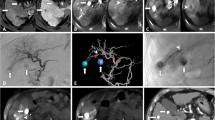Abstract
This study evaluated the usefulness of cone-beam computed tomography (CBCT) during ultraselective transcatheter arterial chemoembolization (TACE) for hepatocellular carcinomas (HCC) that could not be demonstrated on angiography. Twenty-eight patients with 33 angiographically occult tumors (mean diameter 1.3 ± 0.3 cm) were enrolled in the study. The ability of CBCT during arterial portography (CBCTAP), during hepatic arteriography (CBCTHA), and after iodized oil injection (LipCBCT) to detect HCC lesions was retrospectively analyzed. The technical success of TACE was divided into three grades: complete (the embolized area included the entire tumor with at least a 5-mm wide margin), adequate (the embolized area included the entire tumor but without a 5-mm wide margin in parts), and incomplete (the embolized area did not include the entire tumor) according to computed axial tomographic (CAT) images obtained 1 week after TACE. Local tumor progression was also evaluated. CBCTAP, CBCTHA, and LipCBCT detected HCC lesions in 93.9% (31 of 33), 96.7% (29 of 30), and 100% (29 of 29) of patients, respectively. A single branch was embolized in 28 tumors, and 2 branches were embolized in five tumors. Twenty-seven tumors (81.8%) were classed as complete, and 6 (18.2%) were classed as adequate. None of the tumors were classed as incomplete. Twenty-five tumors (75.8%) had not recurred during 12.0 ± 6.2 months. Eight tumors (24.2%), 5 (18.5%) of 27 complete success and 3 (50%) of 6 adequate success, recurred during 10.1 ± 6.2 months. CBCT during TACE is useful in detecting and treating small HCC lesions that cannot not be demonstrated on angiography.



Similar content being viewed by others
References
Takayasu K, Arii S, Ikai I et al (2006) Prospective cohort study of transarterial chemoembolization for unresectable hepatocellular carcinoma in 8510 patients. Gastroenterology 131:461–469
Matsui O, Kadoya M, Yoshikawa J et al (1993) Small hepatocellular carcinoma: treatment with subsegmental transcatheter arterial embolization. Radiology 188:79–83
Yamada R, Sato M, Kawabata M et al (1983) Hepatic artery embolization in 120 patients with unresectable hepatoma. Radiology 148:397–401
Uchida H, Ohishi H, Matsuo N et al (1990) Transcatheter hepatic segmental arterial embolization using Lipiodol mixed with an anticancer drug and Gelfoam particles for hepatocellular carcinoma. Cardiovasc Intervent Radiol 13:140–145
Miyayama S, Matsui O, Yamashiro M et al (2007) Ultraselective transcatheter arterial chemoembolization with a 2-F tip microcatheter for small hepatocellular carcinomas: relationship between local tumor recurrence and visualization of the portal vein with iodized oil. J Vasc Interv Radiol 18:365–376
Binkert CA, Alencar H, Singh J et al (2006) Translumbar type II endoleak repair using angiographic CT. J Vasc Interv Radiol 17:1349–1353
Hirota S, Nakao N, Yamamoto S et al (2006) Cone-beam CT with flat-panel-detector digital angiography system: early experience in abdominal interventional procedures. Cardiovasc Intervent Radiol 29:1034–1038
Georgiades CS, Hong K, Geschwind JF et al (2007) Adjunctive use of C-arm CT may eliminate technical failure in adrenal vein sampling. J Vasc Interv Radiol 18:1102–1105
Miyayama S, Matsui O, Yamashiro M et al (2008) Detection of hepatocellular carcinoma by CT during arterial portography using a cone-beam CT technology: comparison with conventional CTAP. Abdom Imaging (in press)
Virmani S, Ryu RK, Sato KT et al (2007) Effect of C-arm angiographic CT on transcatheter arterial chemoembolization of liver tumors. J Vasc Interv Radiol 18:1305–1309
Murakami T, Kim T, Takamura M et al (2001) Hypervascular hepatocellular carcinoma: detection with double arterial phase multi-detector row helical CT. Radiology 218:763–767
Ishijima H, Koyama Y, Aoki J et al (1999) Use of a combined CT-angiography system for demonstration of correlative anatomy during embolotherapy for hepatocellular carcinoma. J Vasc Interv Radiol 10:811–815
Takayasu K, Muramatsu Y, Maeda T et al (2001) Targeted transarterial oily chemoembolization for small foci of hepatocellular carcinoma using a unified helical CT and angiography system: analysis of factors affecting local recurrence and survival rates. AJR Am J Roentgenol 176:681–688
El-Sheik M, Heverhagen JT, Alfke H et al (2001) Multiplanar reconstructions and three-dimensional imaging (computed rotational osteography) of complex fractures by using a C-arm system: initial results. Radiology 221:843–849
Linsenmaier U, Rock C, Euler E et al (2002) Three-dimensional CT with a modified C-arm image intensifier: feasibility. Radiology 224:286–292
Sasaki A, Kai S, Iwashita Y et al (2005) Microsatellite distribution and indication for locoregional therapy in small hepatocellular carcinoma. Cancer 103:299–306
Miyayama S, Matsui O, Yamashiro M et al (2007) Iodized oil accumulation in the hypovascular tumor portion of early-stage hepatocellular carcinoma after ultraselective transcatheter arterial chemoembolization. Hepatol Int 1:451–459
Kamel IR, Bluemke DA, Ramsey D et al (2003) Role of diffusion-weighted imaging in estimating tumor necrosis after chemoembolization of hepatocellular carcinoma. AJR Am J Roentgenol 181:708–710
Kim YK, Kim CS, Chung GH et al (2006) Comparison of gadobenate dimeglumine-enhanced dynamic MRI and 16-MDCT for the detection of hepatocellular carcinoma. AJR Am J Roentogenol 186:149–157
Kamel IR, Bluemke DA, Eng J et al (2006) The role of functional MR imaging in the assessment of tumor response after chemoembolization in patients with hepatocellular carcinoma. J Vasc Interv Radiol 17:505–512
Author information
Authors and Affiliations
Corresponding author
Rights and permissions
About this article
Cite this article
Miyayama, S., Yamashiro, M., Okuda, M. et al. Usefulness of Cone-Beam Computed Tomography During Ultraselective Transcatheter Arterial Chemoembolization for Small Hepatocellular Carcinomas that Cannot be Demonstrated on Angiography. Cardiovasc Intervent Radiol 32, 255–264 (2009). https://doi.org/10.1007/s00270-008-9468-4
Received:
Revised:
Accepted:
Published:
Issue Date:
DOI: https://doi.org/10.1007/s00270-008-9468-4




